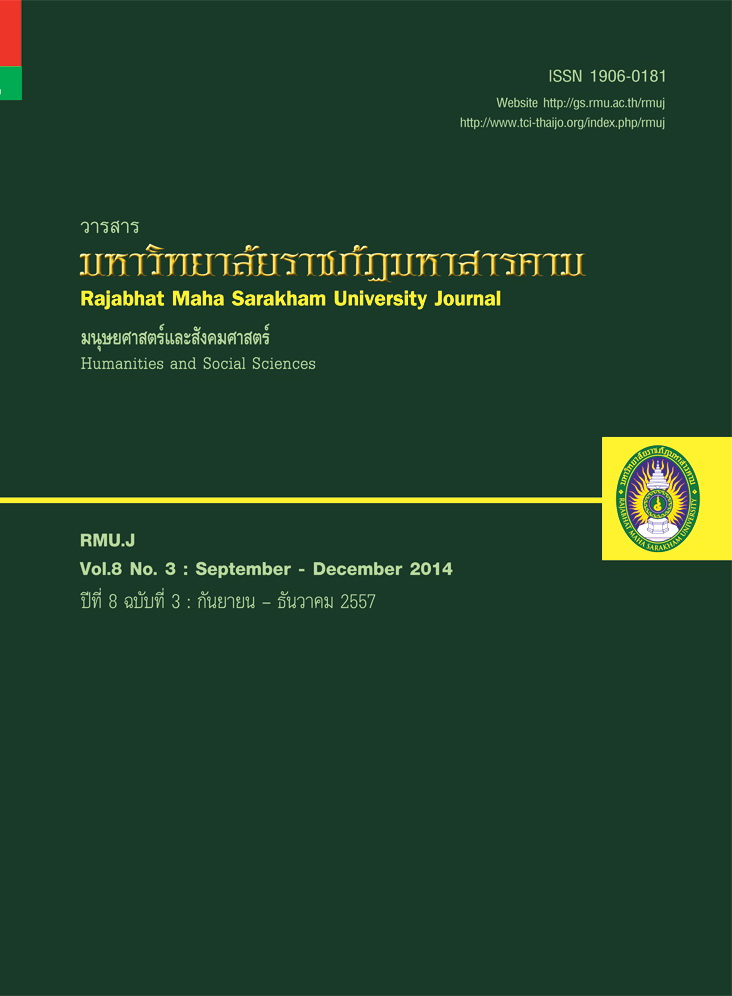การวิเคราะห์มโนทัศน์ที่คลาดเคลื่อนทางคณิตศาสตร์ เรื่อง พื้นที่ผิวและปริมาตร ของนักเรียนชั้นมัธยมศึกษาปีที่ 3 Analysis of Mathematical Misconception on Surface Area and Capacitance in Grade 9th Students
Main Article Content
บทคัดย่อ
การวิจัยครั้งนี้ เพื่อทำการวิเคราะห์มโนทัศน์ที่คลาดเคลื่อนทางการเรียนคณิตศาสตร์ เรื่อง พื้นที่ผิวและปริมาตร ของนักเรียน
ชั้นมัธยมศึกษาปีที่ 3 โดยมีวัตถุประสงค์ ประการแรก เพื่อศึกษาแบบรูปของมโนทัศน์ที่คลาดเคลื่อนทางการเรียนคณิตศาสตร์ ประการ
ที่สอง เพื่อศึกษาสาเหตุของมโนทัศน์ที่คลาดเคลื่อนทางการเรียนคณิตศาสตร์ และประการที่สาม เพื่อศึกษาแนวทางแก้ไขมโนทัศน์ที่
คลาดเคลื่อนทางการเรียนคณิตศาสตร์ กลุ่มเป้าหมายที่ใช้ในการวิจัยครั้งนี้ ได้แก่ นักเรียนชั้นมัธยมศึกษาปีที่ 3 โรงเรียนบ้านหนองเม็ก
จังหวัดอุบลราชธานี ที่เรียนในภาคเรียนที่ 1 ปีการศึกษา 2555 จำนวน 1 ห้องเรียน จำนวนนักเรียน 30 คน ตัวแปรที่ใช้ในการวิจัย คือ
มโนทัศน์ที่คลาดเคลื่อน เครื่องมือที่ใช้ในการวิจัยครั้งนี้ ได้แก่ แบบทดสอบ วิชาคณิตศาสตร์พื้นฐาน เรื่อง พื้นที่ผิวและปริมาตร
ชั้นมัธยมศึกษาปีที่ 3 เป็นแบบอัตนัย จำนวน 10 ข้อ แบบสัมภาษณ์แบบมีโครงสร้าง และแบบประเมินความเหมาะสมของสาเหตุและ
แนวทางในการแก้ไขในมโนทัศน์ที่คลาดเคลื่อนทางการเรียนคณิตศาสตร์ วิเคราะห์ข้อมูลเนื้อหาแล้วนำเสนอโดยการนำเสนอด้วยวิธี
พรรณนา ผลการวิจัยพบว่า
1. แบบรูป แบบรูปของมโนทัศน์ที่คลาดเคลื่อนพบ 5 แบบรูป คือ 1) ด้านการบิดเบือนทฤษฎีบท กฎ สูตร บทนิยาม และสมบัติ
2) ขาดการตรวจสอบในระหว่างการแก้ปัญหา 3) ผิดพลาดในเทคนิคการทำ 4) ด้านการใช้ข้อมูลผิด และ5) ด้านการตีความด้านภาษา
2. สาเหตุ สาเหตุของการเกิดมโนทัศน์ที่คลาดเคลื่อน ได้แก่ ขาดความรู้พื้นฐานในเรื่องที่มีความสัมพันธ์กับเรื่องพื้นที่ผิวและ
ปริมาตร ขาดความเข้าใจในกระบวนการและวิธีการ ด้านการอ่านและการเขียน ขาดความรอบคอบในการนำข้อกำหนดมาใช้ ขาดการ
ฝึกฝนในการทำโจทย์ ขาดระเบียบและความระมัดระวังในการทำงานและการคิดคำนวณ รีบเร่ง ขาดการพิจารณา ไตร่ตรองในการอ่าน
คำสั่งและให้เหตุผล ทำให้เกิดการผิดพลาดในการทำงาน นักเรียนขาดการเชื่อมโยงมโนทัศน์ของแต่ละเรื่องได้
3. แนวทางแก้ไขปัญหา แนวทางการแก้ไขมโนทัศน์ที่คลาดเคลื่อน คือ ฝึกให้นักเรียนตรวจสอบความถูกต้องของกระบวนการ
ในการทำแบบทดสอบ โดยใช้หลักการแก้ปัญหาตามขั้นตอนทั้งสี่ขั้นของโพลยาโดยการสอนเสริม ให้นักเรียนได้เรียนรู้โดยการค้นพบ
ด้วยตนเอง ใช้ชุดการสอนเป็นรายบุคคล การใช้บทเรียนสำเร็จรูป การใช้บทเรียนแบบโปรแกรม แบบฝึกทักษะ หรือการใช้กิจกรรม
กลุ่มเข้ามา สร้างความตระหนักและให้เห็นความสำคัญและผลเสียของการขาดความระมัดระวังในการคำนวณ โดยการเสริมแรงทางบวก
เช่น ชมเชย การให้คะแนน หรือ รางวัล มีการฝึกสมาธิก่อนเรียน และฝึกทักษะการอ่านตีความโจทย์ปัญหาโดยใช้แบบฝึกทักษะและ
ให้นักเรียนเผชิญกับปัญหาที่หลากหลาย
This research aimed to analyze a mathematical misconception on surface area and capacitance of Grade
9th students. The specific purposes were; 1) to study the categories of mathematical misconception, 2) to study
the causes of mathematical misconception, and 3) to study solutions for mathematical misconception in students.
The target group was 30 students who were studying in the first semester of academic year 2012 in grade 9 at
Nongmek School. Research instruments were 10-itemed subjective mathematics test on surface area and
capacitance, structured interview form, and suitability assessment form on the solution of mathematical
misconception. Data were analyzed by content analysis and presented through descriptive analysis.
Results were as follows;
1. The results of this research revealed that misconceptions categories were ranked from highest to
lowest as follows; 1) distortion of theorem, law, formula, definition, and property, 2) unverified solution, 3)
technical error, 4) misuse of data, and 5) misinterpretation of language.
2. The causes of mathematical misconception were the following: students’ lack of basic knowledge
on surface area and capacitance, lack of understanding on process and method, lack of reading and writing
skills, lack of carefulness in following given conditions, lack of practice resolving mathematics items, discipline
and carefulness in working and calculating, and lack carefulness in considering directions and giving reasons.
Another cause was student hastily finished up the test. The aforementioned weakness eventually caused the
mistakes in working and made students incapable of connecting conception between each topic..,
3. Solutions for mathematical misconception in students were as follows; instructing students to verify
the solution by following 4 steps of Polya’s problem solving technique, remedial teaching, having students find
the answers themselves, individually practicing with the programmed lessons, using group activities, awaking
students to realize the undesirable consequences of careless calculation, providing a positive reinforcement
such as praise , scoring, rewarding, having students make meditation before class, and practicing interpreting
various mathematic questions.
Article Details
1. บทความที่ลงตีพิมพ์ทุกเรื่องได้รับการตรวจทางวิชาการโดยผู้ประเมินอิสระ
2. ข้อคิดเห็นใด ๆ ของบทคามที่ลงตีพิมพ์ในวารสารมหาวิทยาลัยราชภัฏมหาสารคาทม นี้เป็นของผู้เขียน คณะผู้จัดทำวารสารไม่จำเป็นต้องเห็นด้วย
3. กองบรรณาธิการวารสารมหาวิทยาลัยราชภัฏมหาสารคาทม ไม่สงวนสิทธิ์การคัดลอกแต่ให้อ้างอิงแสดงที่มา

